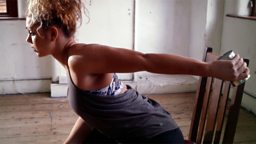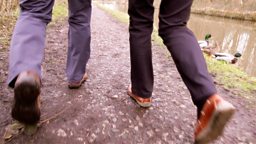The Take a Hike Challenge - #MakeYourMove
Get on your feet and back to basics. Take a walk.

If the thought of moving off the couch exhausts you or you spend a lot of the day seating down at work, then it’s time to work on the strength of your legs and your heart and move a little. Go for a walk.
This challenge is completely personal to you. Start small and work your way up to a longer walk. Take it one step at a time – literally!
The Take a Hike challenge is easy – read through the steps below, figure out what works best for you and make a commitment to yourself to walk daily.
The challenge in a nutshell
| Your | Why |
|---|---|
| Aim | Walk every day. |
| Benefits | Get stronger legs, heart and lungs. Taking a walk can also help clear your mind and work through problems that are on your mind. You’ll feel both physical and mental benefits as you improve your fitness while taking time for yourself. |
| Goal | Get yourself walking and see if you can increase the time and distance you’re covering on a weekly basis. Some days you might have more time than others, but don’t let that stop you from doing what you can. Calculate how many minutes a week you are walking, and try to increase your pace as you start to feel stronger. |
| Next step | Change your environment. If you have been walking in urban areas, start walking around parks or take to the hills and go on a hike. If you are looking for a low cost option, put a notice up in your local supermarket and find people who want to join in and start an urban walking group. Add some gossip to your daily routine. |
Your daily routine
Step 1 – Make it easy
If you are going to succeed in this challenge, you need to make it difficult to find an excuse not to go for a walk every day. The only way you can do that is by making it very easy to achieve your goals.
Start by walking 5 minutes every day. This can be anywhere. In fact, the closer to home or work you decide to walk the better. Now you can’t make excuses about not being able to get there if it’s right outside your door.
It may not be a pretty romp on the hills, but your neighbourhood is a great place to start walking.
Step 2 - Give yourself a purpose
Take your mind off of the time by filling it with a mission. If you are walking in the suburbs or town, start counting lampposts – how many can you walk to in 5 minutes? By counting something stationary like lampposts or street signs, you will notice how much you are improving as 100 lampposts starts to feel easier to walk, or takes less time to achieve.
Non-stationary objects can be fun too, particularly if you are walking with your children. How many dogs can you spot in 5 minutes? Or how many Beetles or Minis have driven by? Or how many houses with cats in the garden have you walked past? Mix it up, have two missions going at once – anything that will take your mind off of the time and give you a sense of doing something differently to the day before. Focusing your mind on something different and happening around you is also a great technique for stress relief.
Step 3 – Make it count
You know how to walk, but to really help with your strength and fitness, keep a nice even stride and pace. Begin your step by landing your heel first and then roll your weight through to your toes.
Good posture helps open up your chest and make it easier to breathe, as well as engaging your core and back muscles.
Don’t tire yourself out on your first week. The key to making walking a habit is to have positive feelings about the activity. If you overdo it early, your legs might feel stiff and sore which will put you off continuing your challenge. Start small, achieve your goals and keep at it.
Step 4 - Know when to take it up a notch
Being kind to yourself by setting the goal of walking 5 minutes every day to start with will make you realise that you can find time to do a little bit of walking. But the challenge is to keep the momentum going.
When you are ready, increase your time and see how many minutes you can do in a week. How many dogs you can see, how many cats in gardens etc. Can you manage to go a little bit faster? You don’t have to speed walk, but if you can start to feel stronger in your legs and less out of breathe after your walk, it means that your body can take a little bit more of a challenge.
Still be kind – you want to keep making this a positive experience, and you want to keep on impressing yourself by how well you are doing – but give yourself the opportunity to do a little bit more as the weeks go on.
If you do fancy going further afield, there are some great trails to be had in the countryside. has more information about the different kinds of walking you can get into across the UK.
Step 5 - Making your steps count
Lots of smart phones now have step counters built into them, monitoring how many steps you take a day. If you’ve got access to one of these, or a pedometer, find out what an average day of walking is for you, then try to increase your total each week.
The recommended amount of exercise by the Chief Medical Office is 150 minutes of moderate exercise each week. It might feel impossible now, but once you start walking daily you might just surprise yourself.
Don’t forget
- Track your results - motivation looks different for everyone, but nothing helps you to see progress like looking back at how much you have achieved.
- If you would like to keep a manual diary, print and keep notes.
- Show us how you are getting on. Use #MakeYourMove on , or to join the conversation and see who else is walking and improving their strength and stamina.
Need more convincing?
This is a great way to appreciate your surroundings and there aren’t many things that can beat the sun on your face as you stroll around the neighbourhood. It might be that you can make walking part of your daily routine, perhaps walking to a friend’s place for a cup of tea or even getting them involved. Time flies by when you’re setting the world to rights with good company. Don’t let the weather get you down either – take your walk indoors by walking laps of the local shopping centre, or walking through the office and up and down stairs to get your walk in. Get creative – it’s part of the challenge.
Top tip
Use podcasts to not only broaden your horizons but give you something else to concentrate on. For example if music is your thing, you could start with podcast which is five minutes long and then as you feel like you can walk for longer, check out podcast which would have you out on your feet for 50 minutes. Or catch up with if you like a bit of 15 minute drama.




